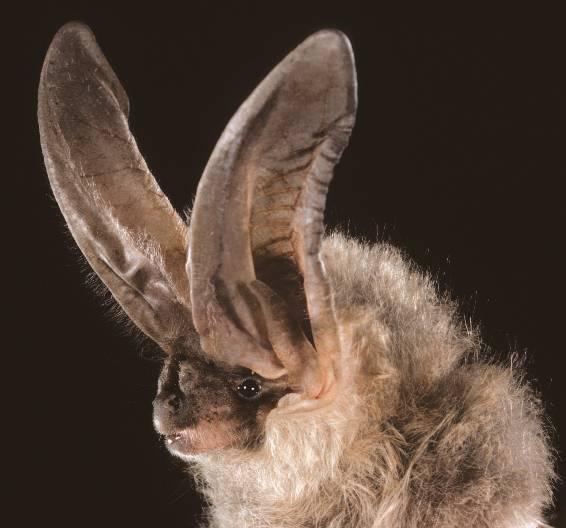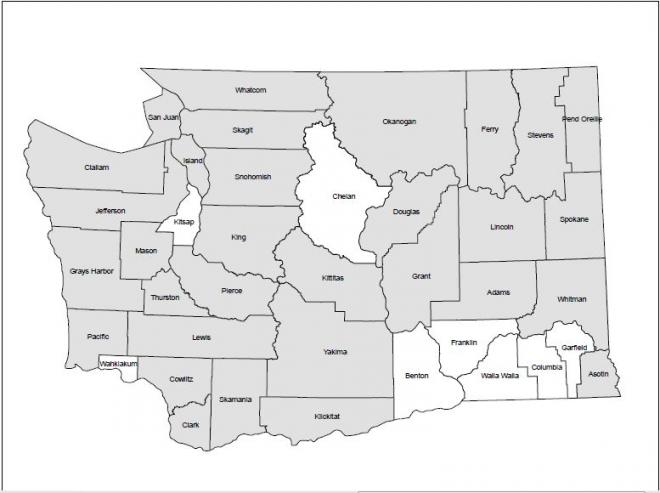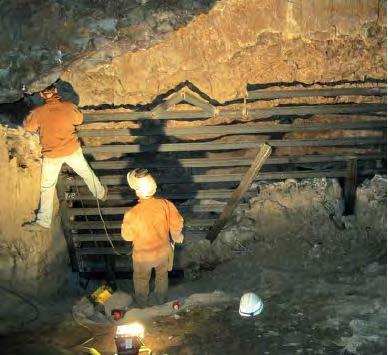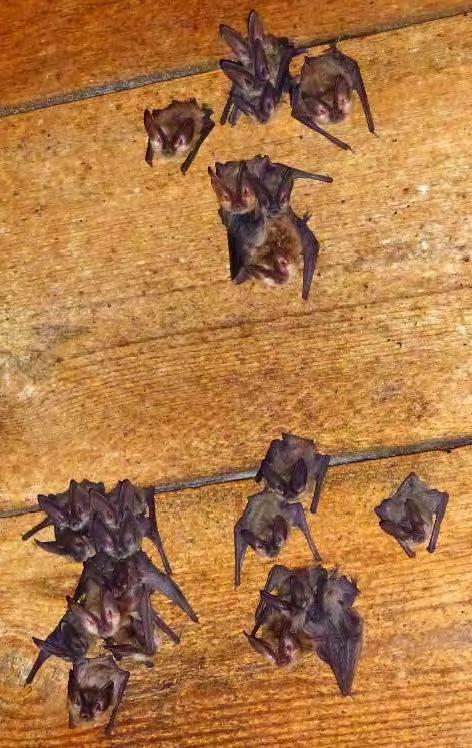Townsend's Big-eared Bat (Corynorhinus townsendii)
This article was originally published by the Washington Department of Fish and Wildlife as part of its annual report Threatened and Endangered Wildlife in Washington.

State Status: Candidate
Federal Status: Species of Concern
Recovery Plans: None
Townsend’s big-eared bat is a medium-sized insectivorous bat with very large ears connected at the base and two prominent lumps on either side of the nostrils (Nagorsen and Brigham 1993, Gruver and Keinath 2006). Five subspecies are recognized, with only C. t. townsendii present in Washington.
Townsend’s big eared bats occupy a broad range of arid and moist habitats. In Washington, this species is found in lowland conifer-hardwood forest, montane conifer forest, ponderosa pine forest and woodland, shrub- steppe, riparian habitats, and open fields (Johnson and Cassidy 1997, Woodruff and Ferguson 2005). Caves, lava tubes, mines, old buildings, bridges and concrete bunkers are commonly used as day roosts in Washington (Senger and Crawford 1984, Woodruff and Ferguson 2005), with rock crevices and very large trees with basal hollows occupied in other regions (Pierson et al. 1999, WBWG 2005). Temperatures within potential roosting structures are particularly important in the selection of day roosts, as well as roost dimensions, sizes of openings, light quality, and extent of airflow (Pierson et al. 1999, Gruver and Keinath 2006). Hibernacula occur mainly in caves, mines, lava tubes, and occasionally in buildings (Pierson et al. 1999, Gruver and Keinath 2006).
Hibernacula feature moderate airflow and stable temperatures typically ranging from -3 to 13°C, with those below 10°C preferred (Nagorsen and Brigham 1993, Doering 1996, Pierson et al. 1999). More than 90% of the diet is comprised of moths (Pierson et al. 1999, WBWG 2005, Gruver and Keinath 2006).
Townsend’s big-eared bats generally occur at low densities across their range (Gruver and Keinath 2006). Long-term population trends are difficult to assess for most western populations because of the scarcity of adequate count data, the species’ dynamic roosting behavior, and the use of multiple roosts under some conditions (Ellison et al. 2003, Sherwin et al. 2003, Gruver and Keinath 2006). In Washington, long-term count data are available for only a small number of roosts. Comparisons of bat numbers during the 1970s-1980s against those in the 1990s-2000s can be made for six hibernacula, with four of these showing increases and two being stable during this period (WDFW WSDM database).
However, two of the sites featuring increases experienced major declines (from >200 bats to ≤30 bats) from the mid-1960s to early 1970s, probably due to researcher activity (Senger and Crawford 1984). One of these has subsequently recovered, but the other remains at less than half its former size. Count data for the 1970s-1980s versus the 1990s-2000s are available for only two maternity colonies in the state, with one showing an increase and one a decrease (WDFW WSDM database). A third site that held a major maternity roost into the 1930s was abandoned by the 1960s and remains unoccupied by breeding bats (St. Hilaire 2012). Townsend’s big-eared bats are typically rarely detected during capture and acoustic surveys in Washington (see Hayes and Wiles in prep.). Because this species is difficult to capture in mist nets and has quiet echolocation (WBWG 2005b), standard capture and acoustic surveys may be poorly suited for measuring abundance.
Human disturbance of roosts (e.g., by recreational cavers and vandals) and closure or reuse of abandoned mines are major threats to Townsend’s big-eared bats (Senger and Crawford 1984, Pierson et al. 1999, WBWG 2005, Gruver and Keinath 2006). Roosts that experience repeated human visitation frequently show severe population declines or abandonment. Loss of roosts in buildings from gradual structural decay, destruction, reuse by people, or deliberate exclusion practices is also a problem. Non-target pesticide spraying to control outbreaks of moth pests (e.g., spruce budworm, tussock moths, and gypsy moths) and other insects on forest and agricultural lands near roosts may affect overall moth abundance, thereby reducing food resources for this species. Degradation and loss of foraging and roosting habitat from timber harvest practices, land conversion, and livestock grazing are other threats.
Monitoring and surveys. A relatively small number of known maternity roosts and hibernacula of this species in Washington are surveyed annually or less frequently by staff from the U.S. Forest Service, WDFW, Cascadia Research Collective, Tacoma City Light, National Park Service, and U.S. Army Corps of Engineers. During 2012, new colonies of this species were reported in San Juan County (maternity site), Stevens County (maternity site), and Island County (hibernaculum).
Roost protection. Gating of caves and mines has been performed to protect the maternity roosts and hibernacula of this species in Washington in recent decades. In 2012, a new gate was installed inside Boulder Cave, Yakima County, to protect a chamber used by hibernating Townsend’s big-eared bats (Figure 3). The gate may also provide a safe area for the return of reproductive females, which used the cave as a maternity site until at least the 1930s. The gate was built by cave-gating expert Jim Nieland, Forest Service staff, volunteers, and WDFW staff, with funding from the U.S. Forest Service and Bureau of Land Management.
Research. A study of winter roosting behavior and roost selection in southern Thurston and eastern Grays Harbor counties continued in 2012 and is being conducted by Cascadia Research Collective.
Bat conservation plan. WDFW is preparing a conservation plan for bats in Washington (Hayes and Wiles, in prep.), which will be completed in 2013. The plan will provide: 1) a summary of bat biology and threats, 2) species accounts for all 15 species of bats living in the state, and 3) strategies and tasks for conserving bats in Washington, including Townsend’s big-eared bats.
Partners and cooperators: U.S. Forest Service, Bureau of Land Management, Cascadia Research Collective, National Park Service, Cascade Grotto, Tacoma City Light, U.S. Army Corps of Engineers, U.S. Fish and Wildlife Service, Oregon Department of Fish and Wildlife, The Nature Conservancy, Joint Base Lewis-McChord.
Literature Cited
Doering, R. W. 1996. Thermal implications of roost site selection in hibernating Plecotus townsendii. Thesis, Idaho State University, Pocatello, Idaho, USA.
Ellison, L. E., T. J. O’Shea, M. A. Bogan, A. L. Everette, and D. M. Schneider. 2003. Existing data on colonies of bats in the United States: summary and analysis of the U.S. Geological Survey’s bat population database.
Pages 127-237 in T. J. O’Shea and M. A. Bogan, editors. Monitoring trends in bat populations in the United States and territories: problems and prospects. U.S. Geological Survey, Biological Resources Discipline, Information and Technology Report USGS/BRD/ITR –2003-0003.
Gruver, J. C. and D. A. Keinath. 2004. Townsend’s big-eared bat (Corynorhinus townsendii): a technical conservation assessment. Rocky Mountain Region, USDA Forest Service, Golden, Colorado, USA. http://www.fs.fed.us/r2/projects/scp/assessments/townsendsbigearedbat.pdf
Hayes, G., and G. J. Wiles. In prep. Bat conservation plan. Washington Department of Fish and Wildlife, Olympia, Washington.
Johnson, R. E. and K. M. Cassidy. 1997. Terrestrial mammals of Washington State: location data and predicted distributions. Pages 67-97 in K. M. Cassidy, C. E. Grue, M. R. Smith, and K. M. Dvornich, editors.
Washington State Gap Analysis – Final Report. Volume 3. Washington Cooperative Fish and Wildlife Research Unit, University of Washington, Seattle, Washington, USA.
Nagorsen, D. W. and R. M. Brigham. 1993. Bats of British Columbia. UBC Press, Vancouver, British Columbia, Canada.
NatureServe. 2009. NatureServe explorer: an online encyclopedia of life [web application]. Version 7.0. NatureServe, Arlington, Virginia. <http://www.natureserve.org/explorer>.
Pierson, E. D., M. C. Wackenhut, J. S. Altenbach, P. Bradley, P. Call, D. L. Genter, C. E. Harris, B. L. Keller, B. Lengus, L. Lewis, B. Luce, K. W. Navo, J. M. Perkins, S. Smith, and L. Welch. 1999. Species conservation assessment and strategy for Townsend’s big-eared bat (Corynorhinus townsendii townsendii and Corynorhinus townsendii pallascens). Idaho Conservation Effort, Idaho Department of Fish and Game, Boise, Idaho, USA.
Senger, C. and R. L. Crawford. 1984. Biological inventory, Mt. St. Helens Cave Basalt Flow Area. Report to Gifford Pinchot National Forest, Vancouver, Washington, USA.
Sherwin, R. E., W. L. Gannon, and J. S. Altenbach. 2003. Managing complex systems simply: understanding inherent variation in the use of roosts by Townsend’s big-eared bat. Wildlife Society Bulletin 31:62-72.
St. Hilaire, J. 2012. Boulder Cave bat survey summary. Okanogan-Wenatchee National Forest, Wenatchee, Washington.
WBWG (Western Bat Working Group). 2005. Species accounts. <http://www.wbwg.org/speciesinfo/species_accounts/species_accounts.html>
Woodruff, K. and H. Ferguson. 2005. Townsend’s big-eared bat, Corynorhinus townsendii. In J. M. Azerrad, editor. Management recommendations for Washington’s priority species, Volume V: mammals. Washington Department of Fish and Wildlife, Olympia, Washington, USA. <http://wdfw.wa.gov/hab/phs/vol5/townsendsbat.pdf>
Source: Washington Department of Fish and Wildlife. 2013. Threatened and Endangered Wildlife in Washington: 2012 Annual Report. Listing and Recovery Section, Wildlife Program, Washington Department of Fish and Wildlife, Olympia. 251 pp.







